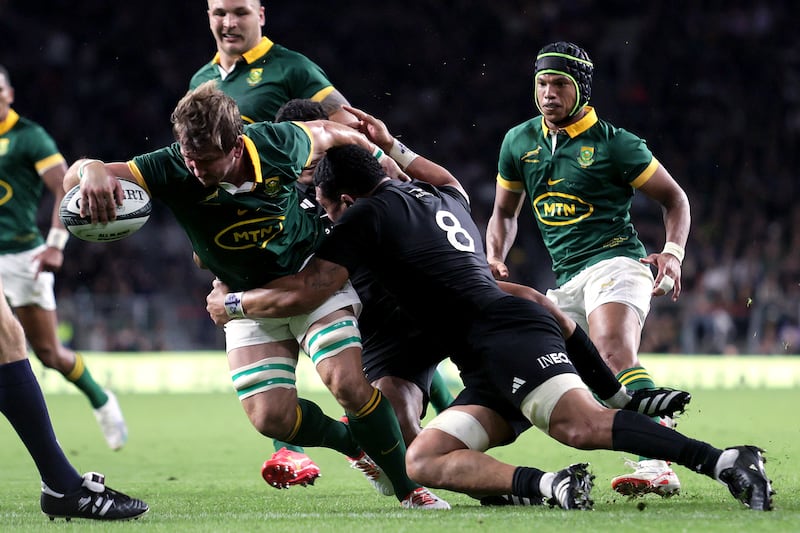South Africa have not ruled out using a 7-1 split on their bench during the Rugby World Cup. Head coach Jacques Nienaber suggested they would be keeping it under consideration following their recent demolition of the All Blacks. Nienaber admitted that he took a huge risk by only having one backline substitute and seven forwards but was happy it worked out.
That kind of “big boy” thinking pushes innovation in one direction and can only mean one thing. The Springboks, if they believe they can monster a team with an abundance of kilo power, will do so.
It might come across as an arcane point, how the bench of a team is divided, but in rugby replacements are tactical and active components, not fallback options. The bench is no longer a group of players waiting for injuries to occur.
“The safest option is a 5-3 split. There is a risk to a 6-2 bench, and a 7-1 bench is high risk. We were fortunate that we didn’t get any injuries in the backline. I don’t know if we will take that risk going forward, but it’s something we’ll look at and consider,” saidd Nienaber, Stuart Lancaster’s replacement at Leinster for the coming season.
The Counter Ruck: the rugby newsletter from The Irish Times
Matt Williams: Ireland must avoid arrogance and pay England the respect they deserve
Owen Doyle: Give the scrum back its purpose or risk damaging the Six Nations - and Australia’s regeneration
Matt Williams: Stopping great teams from playing the way they can play is exceptionally difficult
The gamble meant if more than one of the backline players were injured, South Africa would have to replace them with forwards. That can be challenging, but flankers, particularly, playing in the backline or out on the wing is not an unheard-of ploy, even in Irish teams.
It has always been part of rugby for players to actively seek out mismatches and exploit size disparities, although this time Nienaber has ruffled collars by doing it on an industrial scale.
In 2005 the then Munster coach Declan Kidney, in an experimental stroke, selected openside flanker David Wallace to play on the wing against Scottish side Border Reivers. Wallace was known for his pace and power. It seemed like a logical experiment, and one week later Wallace was back playing openside flanker.
Kidney similarly held the opinion that Irish flanker Denis Leamy was of more benefit to Munster on the pitch than off it, so he picked him to play centre on a couple of occasions. Part of Leamy’s DNA was that he had played in the backline at underage level.
In 2013 Ireland flanker Peter O’Mahony was as surprised as anyone when he was asked to play over half of Ireland’s defeat by Italy on the wing. On that occasion injury thinned the Irish depth. Wing Keith Earls and centre Luke Marshall departed in quick succession and were soon joined on the sidelines by Luke Fitzgerald after the substitute winger incurred a knee problem, so coach Kidney again innovated, shifting flanker O’Mahony to the left wing.
[ The day Ireland ran out of road in RomeOpens in new window ]
Jonah Lomu also started his rugby union career in the backrow before switching to the left wing, while Sam Burgess made the move amid huge controversy for the 2015 World Cup in England.
The cross-code star from rugby league came into rugby union after playing in the backrow for Bath in the Premiership. England, coached then by Lancaster and Andy Farrell, started him in the centre in the World Cup. Later that year he returned to rugby league.
The Springboks’ more extreme benching may trigger alarm bells in other camps because a repeat would have the effect of supersizing the World Cup. South Africa are blessed with naturally big players, where Ireland are not, although the 6ft 6ins and 262lbs Joe McCarthy’s inclusion in the Irish squad is perhaps a practical nod by Farrell and his team towards providing size and strength in the secondrow.

But bringing on an almost entirely new group of forward players, as South Africa did against New Zealand, will set a string of different challenges to other teams.
Not least is how to align smaller players, especially in the latter stages of the match when they are tired and hurting, against a refreshed pack of forwards without having to commit large numbers to simply stopping the ball carrier.
South Africa have made a statement, which is that director of rugby Rassie Erasmus and Nienaber are prepared to be risk takers and are ready to turn the World Cup into a series of stadium-sized arm wrestles with bigger men flooding into the arena in the second half. Less beauty and more beast has now had a proven test run.
Then again, perhaps people are also over-thinking the strategy as backs are much bigger now, some on a par with forwards. Fiji demonstrated in their recent win over England that the differences can be slight. Inside centre Semi Radradra is 6ft 3ins and 100 kilograms while outside him captain Waisea Nayacalevu is 6ft 4ins and 105 kilograms.
There are no laws against using seven forwards on the bench, the only deterrent being that there is jeopardy in the strategy. Except for three frontrow positions, where safety demands that the technical positions of the props and hooker must be specialist, teams can bet the house, as the Springboks did against the All Blacks, on a forward-dominated game.
First up for the ‘Boks is Scotland in Marseilles next week. They are the canaries in the coal mine, another 7-1 airing on the bench not yet discounted by Erasmus and his tactical boffins.















